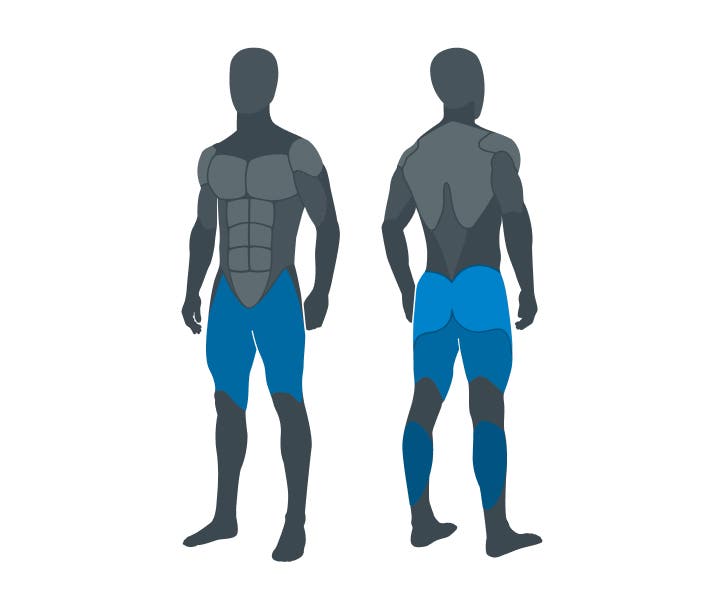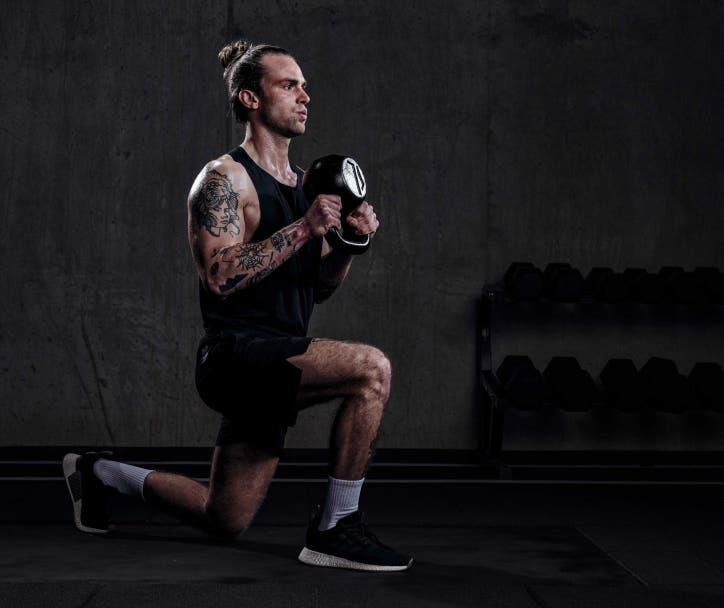Strong legs are definitely something to be admired. What’s more, muscular legs are often a good indication of someone’s athletic capabilities. But powerful legs are not easily earned – it’s all about the work you put in the gym or on the track. Want to develop your legs? Read on to find out how.
What are the main muscles of the legs?
The legs can be divided into two areas: the front and back. On the front side is one of the most important muscles for developing strong legs: the quadriceps (or “quads”). The quads consist of four key muscles, three of which cross the knee and one that crosses the hip and knee. This makes them extremely important muscles when it comes to knee strength and stability.
On the inside of the leg, there is another key muscle group that can straighten, pull in, and internally rotate our leg: the adductors. These muscles essentially adduct (i.e. pull the leg to the inside) but can also aid in straightening the leg when starting in a squat position.

Moving on to the back of the leg, there are two important muscle groups that bring the power: the hamstrings and the glutes. The hamstrings run between the hip and the knee and are responsible for extending the hip and bending the knee. Hamstrings provide stability for the back of our knee, which is vital to avoiding knee injuries.
Next up, the glutes, which can be broken down into the largest glute muscle (gluteus maximus) and smaller glute muscles (gluteus medius and gluteus minimus). While the larger glute muscle primarily straightens our hips and helps rotate our knee to the side, the smaller glute muscles are responsible for lifting our leg to the side. Together they act as the counterpart to the adductor muscle, providing lateral stability for the knee.
Rounding out the lower part of the leg muscles are the calf and shin. At the front of the shin, is the tibialis anterior (or frontal shin muscle) which is responsible for flexing your foot up. Opposite the shin is the calf, where two muscles (the gastrocnemius muscle and the soleus muscle) work together to help push your foot down toward the ground. Both muscles come together at the Achilles tendon and attach at the heel, but the gastrocnemius starts behind the knee and assists in knee flexion. There are of course other muscles in your lower leg, but these are the main movers.
How do the leg muscles function?
Your leg muscles have two main functions: to keep you stable and to keep you moving. But your legs don’t work in silos, so these two key functions are often achieved simultaneously. Take walking, for example your moving leg pushes you forward while your standing leg keeps you balanced. As you move, all the joints in your lower body – hips, knees, and ankles – are flexed and straightened by your leg muscles.
When it comes to strength training, you can split the functionalities into the following:
- Pull - pulling a weight off the floor, such as in a Deadlift
- Push - pushing a weight away (from your body or the floor), such as Squats
Splitting it this way can help categorize exercises and movements that primarily train the front of the legs (anterior chain) or the back of the legs (part of the posterior chain).
Why should you train legs?
Strong legs provide a good foundation for almost any athletic endeavor. Want to run fast? Jump far? Lift heavy? It all comes down to leg strength.
The legs also have a lot of muscle mass to burn energy, which in turn helps to burn more calories.
Lastly, training your legs simultaneously helps strengthen your hips and lower back. That means the more you train, the less back pain. Better yet, if you keep at it, you'll improve mobility as you age. The long-term game is where it’s at.
So, what are you waiting for? Let’s start growing.
The best exercises for your leg muscles
When it comes to targeting the legs, most exercises fall into two categories: bend and lift, with an almost endless number of variations that primarily engage the muscles around the knees and hips. However, there are two staple movements that are king: Squats and Deadlifts. These lifts require the coordination of multiple joints and muscles groups while simultaneously holding the heavy load. Simply put, they require the use of many muscles within one exercise and allow for a greater range of motion. The best part? You get a bigger bang for that Deadlift-buck!
Lateral movements are also incredibly beneficial to develop powerful legs. Exercises such as Side Lunges or Cossacks will strengthen your quads, glutes, and adductors while improving hip mobility. If you want defined calf muscles, throw in some Calf Raises and Jumps.
As a rule of thumb, make sure to switch it up and add variety to your leg training. Mix it up with both unilateral and lateral work – squatting on two legs as well as one. Deadlifting on two legs as well as one. Move laterally and go up on your toes. This will allow you to hit all the muscle groups that are essential for powering up your lower body while simultaneously working on your mobility and stability.

You can crush all these different exercises with a host of tools: dumbbells, barbells, kettlebells and bands can provide good resistance for your body while matching your current fitness level.
If you’re just starting out, bodyweight and bands might be the perfect way to ease into leg training. Once you’ve mastered that, add in some dumbbells to get the legs burning. Eventually, you might want to incorporate a heavier resistance such as a barbell or progress to single-leg training using Pistol Squats.
How to take care of your legs
Taking care of your legs means taking care of your leg joints and muscles. Focus on building a good range of motion in your hips and ankles. This will take stress off your knees and help you to maintain stability even under load.

If you feel stiff or you can’t do certain exercises (yet), try stretching your hips, ankles, and calf muscles first. Stretches like the 90/90, Quad Stretch, Calf Stretch, and Couch Stretch are great options to start with. Also, spend some time working on your Deep Squat. Training this movement will simultaneously help build strength in other squat variations.
Lastly, for maximum strength and to deepen your range of motion, it’s important to improve flexibility and control. Go deep in your Squats if you can. At the same time, control the weight, especially in the lowering phase of an exercise (also called the “eccentric phase”). This will help you boost mobility while avoiding injuries.
Let’s recap
Training legs isn’t easy, but it’s essential to creating a powerful foundation both in training and everyday life. Incorporate hip and knee-dominant exercises through a greater range of motion to build strength in all three dimensions. Keep it fresh, mix it up with unilateral and bilateral work on top of ample mobility for your hips and ankles. This will keep you training hard, and, more importantly, pain-free for the long haul. And when it comes to strong legs, don’t forget that consistency and time are key.